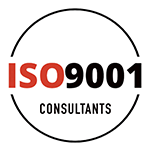ISO 9001 for Traffic Management Companies

Benefits of ISO 9001BENEFITS
for a Construction Company in Australia
Regulatory Compliance
Win Tender Contracts
Efficiency and accuracy
Injury prevention
What is ISO 9001?
ISO 9001 provide organisations with the guidance to create an effective Quality Management System (QMS). The latest version of the standard was created in 2015 and is currently referred to as ISO 9001:2015. The standard had to pass a consensus of industry specialists and member countries to be published. This means that this standard is widely accepted across the globe.
What is Quality Management Systems?
The ISO 9001 standard defines quality management systems as requirements that need to be implemented in a company that wishes to create policies, processes and procedures necessary to enhance the quality of their services or goods to meet the needs of their customers and stakeholders. The benefits of QMS include compliance with applicable regulatory and statutory obligations, enhanced customer satisfaction and consistency in the quality of products or services. QMS form the foundation of your quality assurance activities.
Why is ISO 9001 critical?
As mentioned above, the ISO 9001 standard is internationally recognised and accepted for creating, implementing and maintaining an effective QMS. This standard intends to help organisations of any size or industry to enhance their quality management.
Moreover, as an internationally accepted standard, it is used as a basis for any company that wishes to ensure customer satisfaction and improvement. Moreover, this certification provides your customers with the reassurance that you have established an effective quality management system based upon the seven principles of quality management. This enhances your credibility and brand image.
Seven quality management principles behind ISO 9001 requirements:
The ISO 9001 standard was utilised as the pioneer standard to create industry-specific recommendations. This includes the creation of ISO 13485 for the medical device industry, AS 9100 for the aerospace industry and IATF 16949 for the automotive industry. In fact, despite the global recession, many companies have implemented ISO 9001 QMS across the world.
Some of the main advantages of implementing ISO 9001 requirements include:
- Lesser wastage.
- Better internal management.
- Adaptability to suit both large and small-sized organisations.
- Enhanced efficiency, productivity and profit.
- Enhanced customer retention and acquisition.
- Access to new markets as the standard is globally recognised.
- Accreditation by UKAS.
- Compatibility with other ISO standards.
How to get ISO 9001 certification?
If you wish to get ISO 9001 certified, you can begin your certification journey by meeting all the qualifications and requirements for the certification. You can create your own QMS and then evaluate it to ensure that it meets the requirements of the ISO 9001 standard. For this, you need to consider how your organisation operates, what type of leadership it has, and how you serve your customers. Additionally, you must consider how consistently you evaluate and improve your operations to ensure they are functioning as they are supposed to.
Alternatively, you can purchase a template for the implementation of a QMS. Many companies provide published versions of the QMS templates, and by utilising one of these templates, you can ensure that you are adhering to the requirements stipulated in ISO 9001. If you strictly adhere to the QMS template, you will most likely adhere to the recommendations of ISO 9001.
However, one of the more popular options is engaging with a consultant to help you in your certification process. An ISO consultant has the expertise and knowledge to establish an effective quality management system. Additionally, the ISO consultant will help you set up the system and participate in the troubleshooting process to ensure that you successfully overcome any obstacles.
When you hire an ISO consultant, they will interact with the relevant people in your organisation who hold responsibilities related to quality management. Examples of such relevant roles include members of the top management and process owners. The interaction between the ISO consultant and relevant employees aims to ensure that the necessary controls are in place to meet your company’s objectives and ISO 9001. Moreover, the ISO consultant will also provide valuable inputs and guidance to ensure that your QMS is easily understood and simple and is helping your team perform tasks better. Another benefit of hiring an ISO consultant is ensuring that the documentation is written feasibly and does not conflict or clash with applicable laws or regulations. The benefit of hiring an ISO consultant is that no redundant or unnecessary paperwork is created for you or your team.
We have an eight-step process at Compliance Council to help any organisation in its journey to certification. These steps include:
- Conducting a gap analysis.
- A consultation workshop.
- Drafting system documents that are suited to your organisation’s unique needs.
- Implementation planning (from pre-implementation to project completion).
- Conducting awareness and training programmes for all employees.
- Implementation activities.
- Internal audits to assess progress and readiness.
- Third-party certification audits (stage one and stage two with a certification body) once you are appropriately ready.
What is the certification process?
When an organisation is ready to acquire certification, it must undergo the certification process with a third-party registrar. During the first stage, the certification body will review all the documented information related to your quality management system to ensure that it appropriately aligns with the requirements of the ISO 9001 standard. At this point, they will identify any existing flaws or weaknesses in your system, giving you time to implement corrective actions. At this stage, there is no actual assessment of your implementation activities.
During the second stage, the same certification body will revisit your organisation after the predetermined period to see if you have made the necessary improvements. During the second stage, the implementation of the QMS is also assessed to ensure that the system is functioning as it is meant to. If all the requirements are aligned, you can get your certification. If any flaws are found, you will have more time to make the necessary fixes. You cannot be granted certification until your organisation has made all the necessary improvements, and once you do, you may have to undergo another audit to achieve the certification.
Once your quality management system becomes certified, you must undergo surveillance audits to maintain its validity. The validity of your ISO 9001 certificate is for three years. A surveillance audit ensures that your QMS still adheres to ISO 9001. Two years after your initial certification, you will have to undergo surveillance audits, and each of these will become less intensive than your initial certification audit. You will have to undergo a comprehensive and strict re-certification audit at the end of these three years.
What are the requirements of ISO 9001?
If your organisation is ready to become ISO 9001 certified, it may be helpful to familiarise yourself with the requirements of the QMS. In this manner, you can ensure certification by adhering to the recommendations and clearing the upcoming audits. Here are some of the critical requirements of ISO 9001:
- Gaining a deeper understanding of the organisation’s context: The organisation must identify the internal and external issues that could impact the direction of its quality objectives. These are issues that either interfere with or boost the organisation’s ability to achieve its desired quality outcomes. A great example is to look into any external policies that could affect your organisation’s operations, including government guidelines for import and export.
- Leadership: An organisation’s top management must be fully invested in leading it towards its quality objectives. Leaders of the organisation must showcase their commitment to upholding the values of the QMS and enhancing customer focus. Within an organisation, all employees should be able to understand who holds the responsibilities and roles related to leadership. Leaders must be accountable for the effectiveness of the QMS by ensuring that all procedures are followed and consistently evaluating the processes. This ensures that the QMS aligns with the strategic direction of the organisation.
- Planning: With adequate planning, an organisation can avoid risks and explore opportunities that the QMS presents. This is done by establishing appropriate quality objectives for the QMS and creating a plan to evaluate effectively if these objectives are being achieved. If any changes are made to the QMS, they should be planned over time and implemented gradually. Planning is critical for smooth, hassle-free, intelligent and efficient operations. Suppose your company’s client wants to change their goals mid-project. In that case, your company should sit down and assess how this change will affect their processes, what modifications need to be made, how the timeline changes, and determine additional costs.
- Support: For the effective implementation of the QMS, an organisation needs to establish, implement, improve and maintain its processes. Establishing which people within the organisation are responsible for managing the above functions is also beneficial. Moreover, it is also helpful to ensure that proper infrastructure and environment are provided to reach the laid out objectives. Whenever a company acquires a big project, it should always measure whether they are adequately equipped in terms of space, technology or manpower. If not, it is beneficial to consider adding new people, resources and tools into the workspace.
- Operation: An organisation must execute specific processes to provide its products and services. This can be done by communicating with the customers in a manner that is informative in terms of expectations and consistency. To meet the customers’ requirements, it is necessary to create consistency in the quality of products and services and offer timely delivery. If a product does not meet the output you are committed to, you should ensure it does not reach the customer. Consequently, you should revisit the production processes to identify the root cause of this non-conformance. Hence, it is necessary to assess processes, including storage, transport, setting, monitoring, dispatch, etc.
- Evaluation: Organisations need to determine how to monitor and measure their performance. Regular audits should be conducted to ensure they meet their quality policies and objectives. For example, suppose the number of customer complaints is increasing. In that case, the company needs to introspect and evaluate their customer feedback to reflect upon the processes that are not working to determine improvement strategies.
- Improvement: One of the most critical aspects of the QMS is continual improvement. Organisations should look at areas where they have been experiencing complaints or nonconformities to figure out how these issues can be addressed. Additionally, they should consistently evaluate the effectiveness of the QMS to determine if any areas can make their organisation more effective, efficient or sustainable. If a client is unhappy with how a project is being executed, the organisation should sit down and identify where the breakdown occurs. Corrective steps must be taken to mitigate any risks and rectify issues so that problems do not arise again.
We are here to help you get your ISO 9001 certificate for your traffic management company
Acquiring ISO certification can grant you a competitive advantage by increasing your operational efficiency, improving your consistency, enhancing the quality of your services, and uplifting your business credibility and authority to retain and acquire customers. Contact us to begin your hassle-free, stress-free and smooth certification journey.













